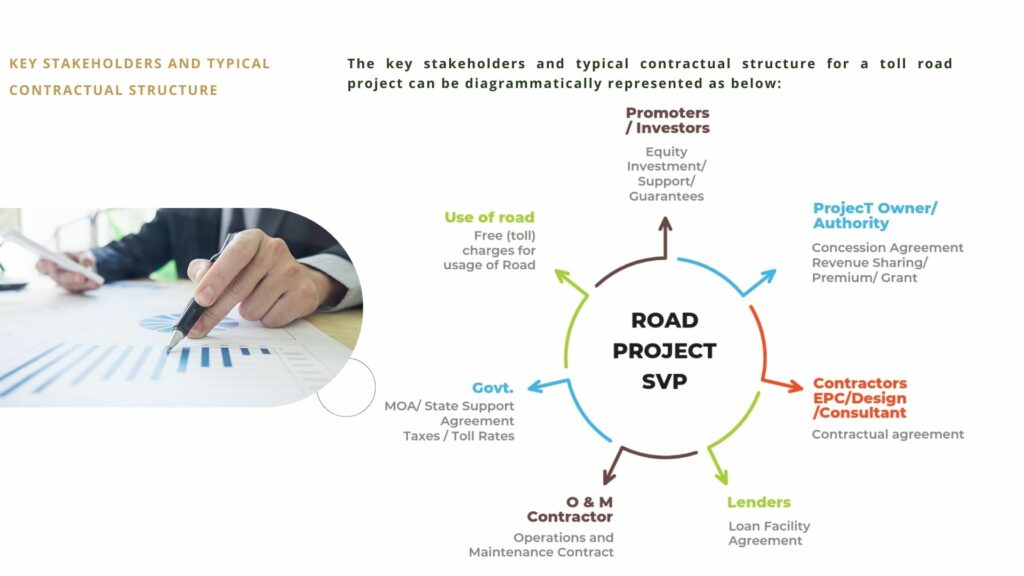
Recently, as a massive move, the Inter-Ministerial Committee (“IMC”) of the Ministry of Road Transport and Highways (Highways Section) of the Government of India (“the Ministry”) in its meeting held on April 1, 2022, concurred with the proposal permitting a change of ownership from 2 (two) years to 1 (one) year after the commercial operation date (“COD”).
Subsequently, a circular bearing no. NH- 24028/14/2014-H (Vol Il) (E-134863) (“the Circular”) dated May 23, 2022, regarding the change in ownership clauses in the Model Concession Agreement (“the Agreement or MCA”) of BOT (Toll) projects was introduced.
Before getting into the peculiarities of the circular, let us get a brief idea of what is BOT (Toll) Project.
The National Highway Authority of India (“NHAI”) has adopted primarily 4 (four) types of national highway projects in the public-private partnership model, as follows:
| Sr. No. | Type of highway models | Brief Explanation |
| 1. | BOT (Toll) | This model is a public-private partnership in which the private developers/operators, invest in toll-able highway projects and are entitled to collect and retain toll revenue for the tenure of the project concession period. The private developer/operator, who eventually becomes a concessionaire, is responsible for the design, development, operation, and maintenance (O&M) of the project for the entire concession period after it is developed and put to commercial use. On the expiry of the concession period, the facility is transferred to the authority (NHAI). |
| 2. | BOT (Annuity) | In this model, responsibility for the design, development, and O&M of the road project for the entire concession period is vested with the concessionaire for the Project. But, unlike the BOT (Toll) projects, the revenue of the Concessionaire is generated through annuity payments by NHAI during the concession period. |
| 3. | Hybrid Annuity Model (HAM) | In this model, 40% of the project cost is paid by the government or as construction support or grant to the private developer. The rest is funded by the successful bidder during the construction period. Even for these projects, the revenue of the Concessionaire is generated through annuity payments by NHAI during the concession period. |
| 4. | Toll Operate Transfer (TOT) | In this model, the right of collection and appropriation of toll for selected operational national highway projects constructed through public funding are mandatorily assigned to concessionaires for a pre-determined concession period against upfront payment for a lumpsum amount to NHAI. |
The key stakeholders and typical contractual structure for a toll road project can be diagrammatically represented as below:

FEATURES OF A BOT (TOLL) PROJECT
Original- Clause 1.1 read with Article 48 of the Agreement which defines the term “Change in Ownership” states that “a transfer of the direct and/or indirect legal or beneficial ownership of any shares, or securities convertible holding of the {Selected bidder / Consortium Members}, together with {it’s/their} Associates, in the total Equity to decline below 51% (fifty-one per cent) thereof During Construction Period and two years thereafter; provided that any material variation (as compared) to the representation made by the Concessionaire during the bidding process for the purposes of meeting the minimum conditions of eligibility or for evaluation of its application or Bid, as the case may be) in the proportion of the equity holding of {the selected bidder/any Consortium Member} to the total Equity, if it occurs prior to completion of a period two years after COD, shall constitute Change in Ownership”;
Amendment-The said Circular reduces the period of the constitution of change in ownership from 2 (two) years (as stated in the definition above) to 1 (one) year after COD.
Original- The aforesaid sub-clause states that the concessionaire shall not undertake or permit any Change in Ownership, except with the prior approval of the authority.
Amendment- The Circular amends Clause 5.3.1 to include a few conditions for the approval from the authority for undertaking Change in Ownership. The conditions are as follows:
Original- The aforesaid clause states that “the Concessionaire shall at no time undertake or permit any Change in Ownership except in accordance with the provisions of Clause 5.3 and that the {selected bidder/Consortium Members), together with {its/their} Associates, hold not less than 51% (fifty-one per cent) of its issued and paid-up Equity as on the date of this Agreement, and that no member of the Consortium whose technical and financial capacity was evaluated for the purposes of pre-qualification and short-listing in response to the Request for Qualification shall hold less than 26% (twenty-six per cent) of Equity during the Construction Period and two years thereafter; Provided further that any such request made under Clause 5.3, shall at the option of the Authority, be required to be accompanied by a suitable no objection letter from the Senior Lenders.”
Amendment- The Circular reduces the said period of 2 (two) years to 1 (one) year for holding 51% and 26% equity, respectively, during the construction period and thereafter, in the case of consortium members.
Over the last decade, the Government continued making efforts to revive the BOT model. In fact, in the current Financial Year, multiple projects under the said model would be opened for bidding.
Considering the above-discussed amendment of transferring ownership on the expiry of one year after the commercial operation date, monetization of such projects by the promoters by disposing of their stake is likely to have a positive impact on their ability to undertake more projects.
Whilst this appears to be the main objective behind the amendment, neither NHAI nor the lenders would allow any change in ownership during the construction period, since that is the most important aspect of the project, that is, the SPV, which is the successful bidder, is owned and controlled by the promoters, whose experience in the road construction and their financial status, form the basis of being qualified to take up the project. The extension beyond one year after the construction period is intended to achieve consistency and stability in the operation of the project, after the expiry of which dilution of the promoters’ stake in the SPV would not affect the project highway, its operation and maintenance and generation of revenue from the project, and thus, such dilution is not likely to hamper the interests of NHAI or the lenders.
Disclaimer: The information contained in this newsletter does not, and is not intended to, constitute legal advice; instead, all information, content, and materials available herein are for general information purposes only.
[1] Article 5 deals with Obligations of the Concessionaire.
[2] Punch List shall mean document prepared by the contractor that lists any work that is not complete, or not completed correctly.
[3] Article 7 deals with Representations and Warranties.